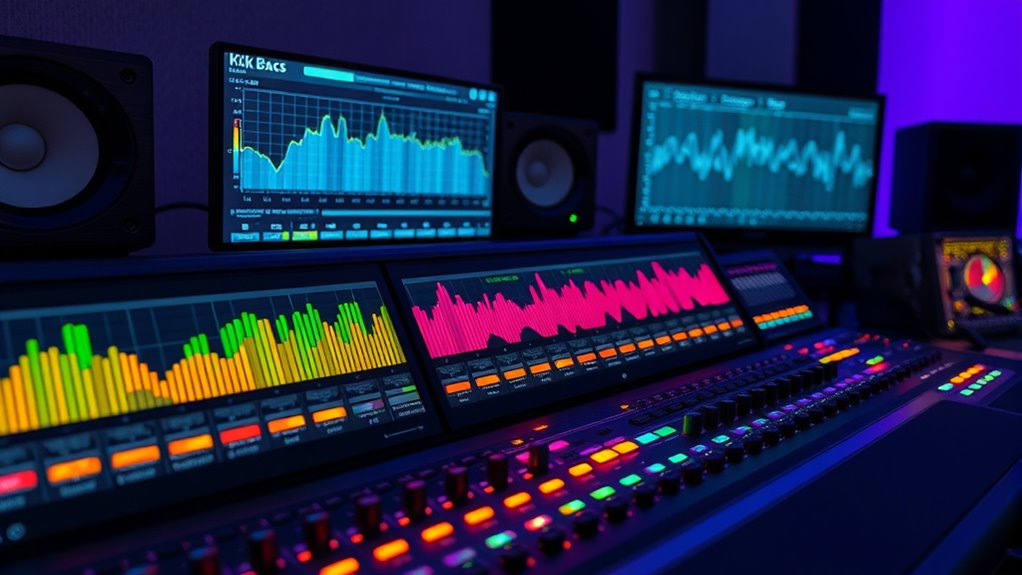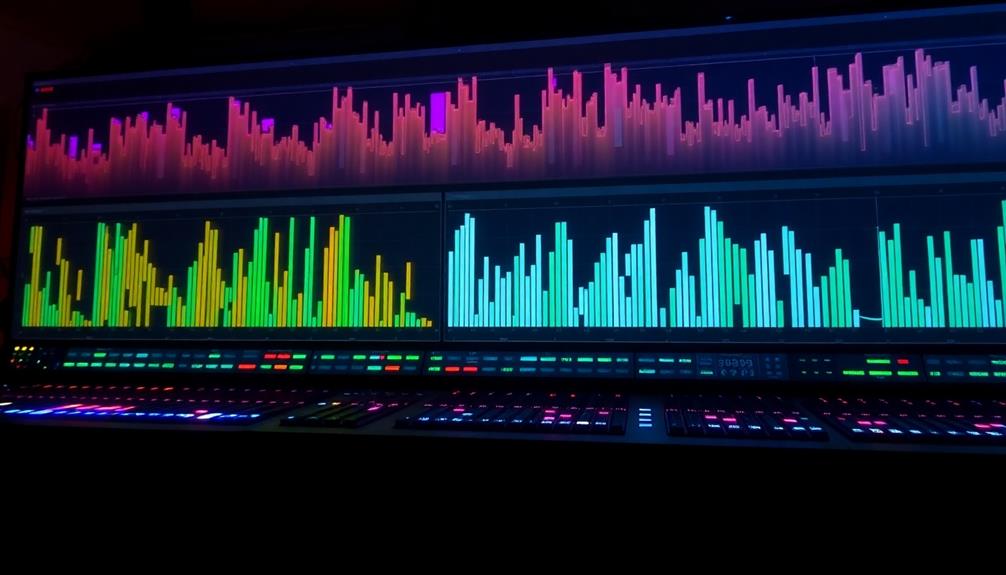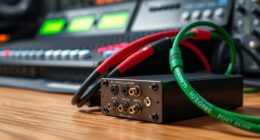To achieve a tight, balanced kick and bass relationship, focus on managing their spectral interaction by EQ carving to prevent overlap in key frequency ranges, especially around 60-100 Hz. Guarantee phase coherence by checking waveforms and using polarity adjustments to prevent cancellation. Keep groove and timing tight with accurate alignment and sidechain compression to create rhythmic space. Mastering these elements helps your low-end sound clear and powerful—continue exploring for detailed techniques to perfect this balance.
Key Takeaways
- Proper spectral balance and EQ techniques ensure kick and bass occupy distinct frequency ranges, preventing muddiness and masking.
- Maintaining phase coherence between kick and bass enhances low-end punch and prevents cancellation effects.
- Precise timing and transient alignment create a cohesive groove and improve overall low-end impact.
- Creative sidechain compression and modulation add rhythmic movement and space in the low end.
- Balancing levels, utilizing stereo imaging, and analyzing spectral interactions optimize the relationship between kick and bass.
The Role of Spectrum in Kick and Bass Alignment

Have you ever wondered why your kick and bass don’t sit well in the mix? It often comes down to their harmonic content and spectral balance. The spectral balance determines how different frequencies are distributed across your sound spectrum. When the kick and bass share overlapping harmonic content in similar frequency ranges, they clash and muddy the mix. To improve alignment, you need to analyze their spectral balance, ensuring each element occupies its own space while complementing each other. This might involve cutting some frequencies from one instrument or boosting others to create clarity. Additionally, understanding your resources and tools, such as spectral analyzers, can help you identify problematic overlaps more precisely. By understanding how the harmonic content interacts, you’ll craft a more cohesive, punchy rhythm section where both kick and bass work together smoothly.
Understanding Frequency Ranges of Kick and Bass

Understanding the frequency ranges of kick and bass is essential for achieving a balanced mix. The kick typically occupies the low-mid frequencies, around 60 to 100 Hz, providing punch and weight. Bass, on the other hand, spans from about 40 to 250 Hz, covering subharmonic resonance and fundamental tones. Overlapping these ranges can cause frequency masking, where one sound hides the other, muddying the mix. To prevent this, you need to identify where each element sits and carve out space accordingly. Recognizing the subharmonic resonance of your bass helps you control its low-end presence without cluttering the kick. By carefully managing these frequency ranges, you ensure clarity and punch, making your kick and bass work together cohesively rather than competing for the same sonic space. Understanding frequency masking is crucial to prevent clutter and maintain clarity in your mix.
The Impact of Phase Coherence on Low-End Clarity
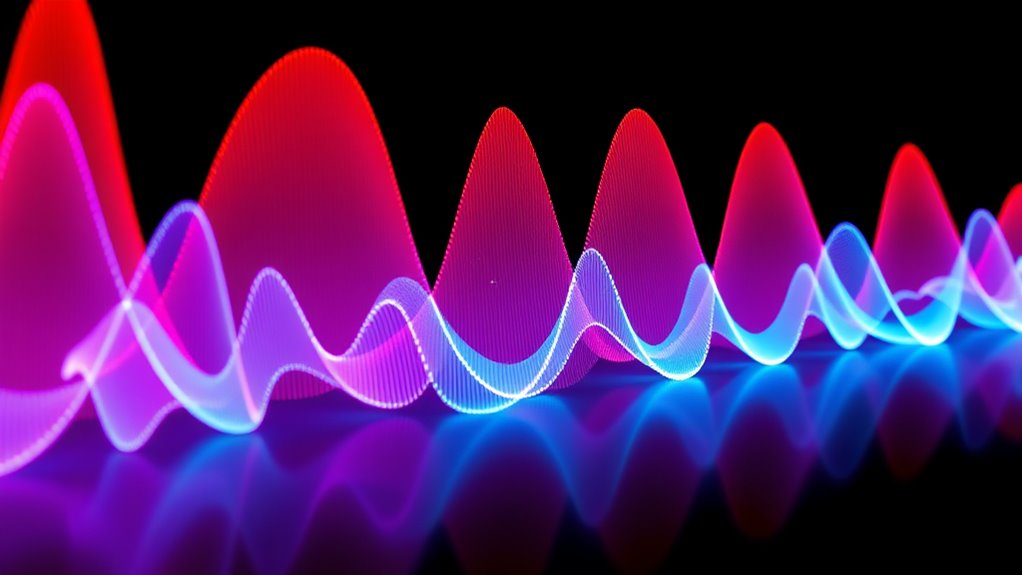
Phase coherence plays a crucial role in achieving a clear and tight low-end in your mix. When your kick and bass are in proper phase correlation, their waveforms align, enhancing low end clarity. If they’re out of phase, they cancel each other out, resulting in a muddy or weak bass response. To optimize phase coherence, you should:
- Check phase correlation meters regularly
- Align waveforms digitally or manually
- Use stereo imaging tools to maintain consistency
- Avoid phase-inverted signals in your signal chain
Maintaining proper phase ensures that the low frequencies reinforce each other rather than clash or cancel. This clarity allows your kick and bass to sit well together, creating a punchy, cohesive groove. Ultimately, understanding and controlling phase coherence boosts the impact and precision of your low-end.
Identifying and Correcting Phase Issues

To effectively identify and correct phase issues, you need to actively listen and analyze your tracks for signs of cancellation or reinforcement problems. Listen carefully for a thin, hollow sound or a loss of depth, which can indicate phase cancellation. Use phase correlation meters or stereo imaging tools to check if your kick and bass are causing stereo imbalances. If your sound collapses when phases are misaligned, it’s a sign of phase issues. To fix this, try flipping the polarity of one track, adjusting timing, or nudging tracks slightly to improve phase alignment. Ensuring proper phase coherence enhances stereo imaging and tightens the low-end, giving your kick and bass a more cohesive, powerful groove. Incorporating sound design techniques can further help identify and resolve phase problems effectively.
Techniques for Blending Kick and Bass Seamlessly

To blend kick and bass seamlessly, you need to focus on matching their frequency ranges and guaranteeing they complement each other. Using phase alignment techniques helps keep them in sync, preventing muddiness or dissonance. Additionally, balancing their volumes dynamically ensures they sit well in the mix without overpowering or getting lost. Consulting sound engineering best practices can further enhance your mixing techniques and achieve a professional sound.
Frequency Range Matching
How do you guarantee your kick and bass sit together without clashing? The key is effective frequency range matching. Start by identifying the core frequencies of each element to prevent harmonic blending issues. Use EQ to carve out space, reducing frequency masking that causes muddiness. Focus on emphasizing the punchy midrange of the kick and the sub-bass of your bassline, ensuring they complement rather than compete. Consider sidechain compression to dynamically manage overlapping frequencies. By carefully balancing their frequency ranges, you create a clean, cohesive sound. Additionally, understanding the role of AI in media and entertainment can inspire innovative techniques for sound design and mixing.
Phase Alignment Techniques
Ensuring your kick and bass are in phase is essential for a tight, powerful sound. One effective phase alignment technique involves checking for phase inversion—if your sounds cancel out, flip the phase to align peaks. Using a time delay tool can help you adjust the bass slightly, syncing it precisely with the kick’s transient. This prevents phase cancellation and creates a cohesive low end. Here’s a quick reference:
| Technique | Purpose |
|---|---|
| Phase Inversion | Corrects phase cancellation issues |
| Time Delay Adjustment | Synchronizes wave peaks for clarity |
| Visual Phase Meter | Visualize phase relationship |
| Listening Test | Confirm seamless blending by ear |
Additionally, understanding the audio hardware and how it influences phase can help optimize your setup for the best sound. These methods help you achieve optimal phase alignment, ensuring your kick and bass sit perfectly together.
Dynamic Volume Balancing
Achieving a seamless blend between kick and bass often hinges on dynamic volume balancing. By carefully adjusting the level balancing, you ensure each element complements the other without overpowering or getting lost. Use your ears to guide your adjustments, making subtle changes to maintain clarity and groove.
- Automate volume faders to adapt to song sections
- Use compression to control dynamic volume fluctuations
- Focus on consistent level balancing during mixing
- Solo kick and bass to fine-tune their relationship before blending
Implementing these techniques helps maintain a natural, cohesive sound, allowing the kick and bass to work together seamlessly in the mix. Proper dynamic volume control emphasizes their relationship and enhances the overall groove.
How to Use EQ to Shape the Kick and Bass Relationship

Using EQ effectively allows you to carve out space for the kick and bass in your mix, ensuring they complement rather than clash. Focus on reducing overlapping frequencies by cutting unnecessary low-end from the bass or slightly attenuating dominant kick frequencies. This prevents harmonic resonance issues that can muddy the mix. You can also enhance stereo imaging by subtly boosting midrange or high-end frequencies in the bass to create separation. Conversely, gently cutting specific frequencies from the kick can help it punch through the mix more clearly. Use narrow Q settings to target problem areas precisely. The goal is to balance both elements so they work together seamlessly, each occupying its own sonic space, which ultimately maintains clarity and drive in your low end. Additionally, understanding the frequency spectrum can help you make more informed EQ decisions to achieve a balanced mix.
The Importance of Groove and Timing in Low-End Dynamics

Getting the groove right is key to making your low-end feel powerful and tight. When you align your kick and bass precisely, the rhythm becomes more punchy and cohesive. This timing guarantees the overall energy and ensures your groove keeps listeners hooked. Understanding how to synchronize these elements can also enhance the overall interpersonal communication styles, creating a more unified sound.
Tightening Beat Alignment
Why is tight beat alignment essential for the relationship between kick and bass? When your kick and bass are precisely aligned, they create a solid foundation that enhances groove and prevents phase cancellation. Misaligned sounds can lead to phase issues, causing parts of the low-end to cancel out or become muddy. Proper timing guarantees these elements work together seamlessly, reducing spectral masking where frequencies clash and obscure clarity. To tighten your beat:
- Use transient detection to align hits accurately
- Adjust timing in your DAW’s grid or via nudging
- Check for phase issues with stereo meters or phase correlation tools
- Listen critically to ensure the kick and bass complement rather than clash
- Ensuring consistent timing accuracy across your low-end elements can significantly improve the overall sound quality.
This careful alignment boosts low-end punch and clarity, making your groove tighter and more impactful.
Enhancing Low-End Feel
Once your kick and bass are aligned tightly, the next step is to focus on how their groove and timing influence the overall low-end feel. You can enhance this by paying attention to their harmonic content, ensuring it complements rather than clashes. Transient shaping plays a key role here—by emphasizing or softening transients, you control the punch and sustain, making the low-end more cohesive. Groove isn’t just about timing; it’s about how these elements interact rhythmically, creating a natural bounce. When you lock in perfect timing and shape transients effectively, the low-end becomes more dynamic and lively. This results in a groove that feels both tight and expressive, elevating the overall impact of your mix’s bass and kick relationship. Additionally, utilizing sound analysis technology can help you identify subtle timing discrepancies and harmonic clashes, allowing for precise adjustments to enhance your low-end groove.
Using Sidechain Compression to Enhance the Groove

Sidechain compression is a powerful technique for shaping the groove between kick and bass by creating a rhythmic pulsing effect. It allows you to achieve sidechain pumping, where the bass volume ducks in sync with the kick, enhancing the groove’s dynamics. This ducking effect ensures the kick cuts through the mix without overpowering the bass, creating space and clarity. To get the most out of sidechain compression, experiment with different attack and release times to match the groove’s rhythm. Use subtle settings for a natural feel or more aggressive settings for a pronounced pulsing effect. Properly applied, it adds movement and groove to your track.
- Synchronize sidechain pumping with your track’s rhythm
- Use ducking effects to create space in the low end
- Adjust attack and release for desired pulsing intensity
- Combine with other processing for unique groove textures
Creative Strategies for Enhancing the Low-End Together

To effectively enhance the low-end together, you should experiment with layering different bass sounds and using EQ to carve out space for each element. Incorporate bass modulation to add movement and interest, subtly shifting pitch or filter parameters over time. This keeps the bass feeling dynamic and engaging. Additionally, applying low end saturation can help glue your kick and bass together, increasing warmth and richness without muddying the mix. Focus on balancing the levels so that each element complements the other, avoiding frequency clashes. Use subtle compression to control dynamics, ensuring consistency. By creatively combining bass modulation, saturation, and careful EQ, you craft a cohesive, powerful low-end that supports the groove and maintains clarity throughout your track.
Final Tips for Achieving a Tight, Cohesive Low-End Mix
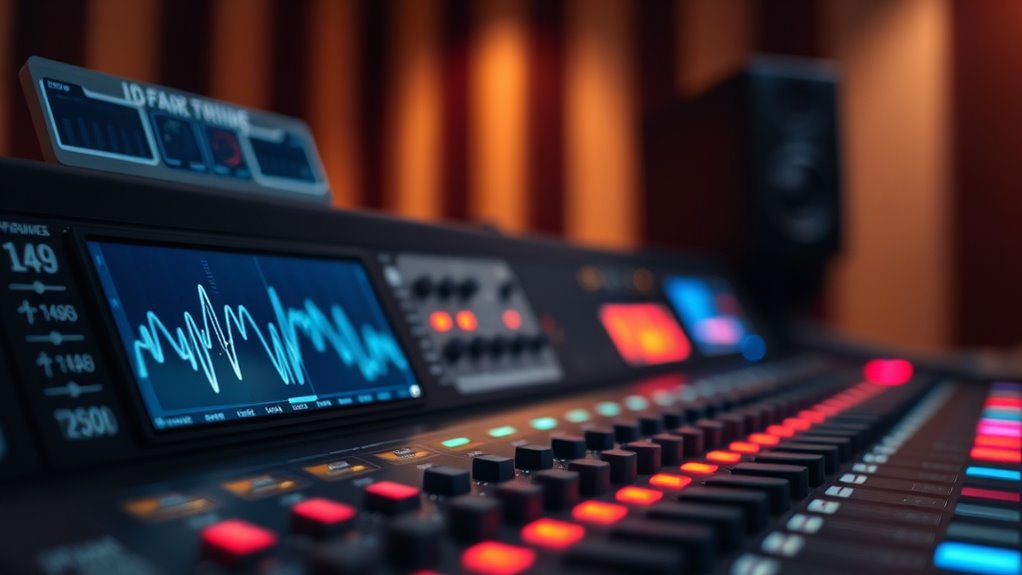
Achieving a tight, cohesive low-end mix hinges on precise balance and meticulous attention to detail. To do this, focus on aligning the harmonic content of your kick and bass, ensuring they complement each other without clashing. Use stereo imaging wisely to create space and prevent muddiness, keeping essential elements centered while spreading the rest across the stereo field. Consider EQ cuts to carve out overlapping frequencies and enhance clarity. Additionally, use subtle sidechain compression to maintain rhythm and separation.
Achieve a tight low-end by balancing harmonic content, stereo imaging, EQ, and subtle sidechain compression.
- Fine-tune harmonic content to prevent masking
- Maintain focused stereo imaging for clarity
- Use EQ and sidechain creatively
- Regularly reference your mix on different systems
Frequently Asked Questions
How Does Stereo Imaging Affect Kick and Bass Cohesion?
Stereo imaging greatly influences how kick and bass sound together. When you maintain proper phase alignment, the kick and bass stay cohesive and punchy. Wide stereo imaging can make your mix feel spacious, but if you don’t keep phase alignment in check, the elements might clash or lose focus. Focus on balancing stereo imaging and phase to guarantee your kick and bass work together seamlessly, creating a tight, impactful groove.
What Are Common Mistakes When Aligning Kick and Bass Spectra?
Aligning kick and bass spectra is like tuning two instruments to harmony. A common mistake is ignoring phase misalignment, which causes sounds to cancel each other out. You might also overlook spectral masking, where bass frequencies drown out the kick, muddying the mix. Always check your EQ and phase relationships, ensuring both elements complement each other instead of competing, to create a clear, punchy low end.
How Can Modulation Effects Improve Low-End Groove?
Modulation effects can notably boost your low-end groove by adding movement and warmth. Using chorus, flanger, or phaser on your bass or kick creates subtle variations that make the low end feel more lively and cohesive. These effects enhance low-end enhancement, preventing it from sounding static or muddy. Experiment with different modulation settings to find the right groove, ensuring your kick and bass work together dynamically and punchily.
What Role Do Compression Settings Play in Kick and Bass Interaction?
You use compression settings to shape how your kick and bass interact. Sidechain compression helps create space by ducking the bass when the kick hits, maintaining clarity. Proper frequency balancing with compression prevents muddiness and guarantees both elements sit well in the mix. Adjust the attack and release times to groove naturally, giving your low-end a tight, punchy feel that enhances the overall rhythm and energy of your track.
How Can I Automate to Enhance Low-End Dynamics Throughout a Track?
To enhance low-end dynamics throughout your track, you can automate your mix using dynamic automation and sidechain compression. Automate the threshold and ratio of your sidechain compressor to create rhythmic pulsing or smooth progressions. This approach allows you to control how the kick and bass interact, emphasizing punch during certain sections and relaxing in others. Dynamic automation guarantees your lows stay lively and well-balanced, maintaining groove and energy across the track.
Conclusion
Now that you’ve mastered the spectrum, phase, and groove, your low end should sound as tight as a drum and as smooth as butter. Imagine your kick and bass as a perfectly synchronized dance duo—no awkward moves or off-beat steps. With these techniques, your mix will groove so seamlessly, even your neighbors will tap along. Just remember, a little science and a lot of feel can turn chaos into a low-end masterpiece.

